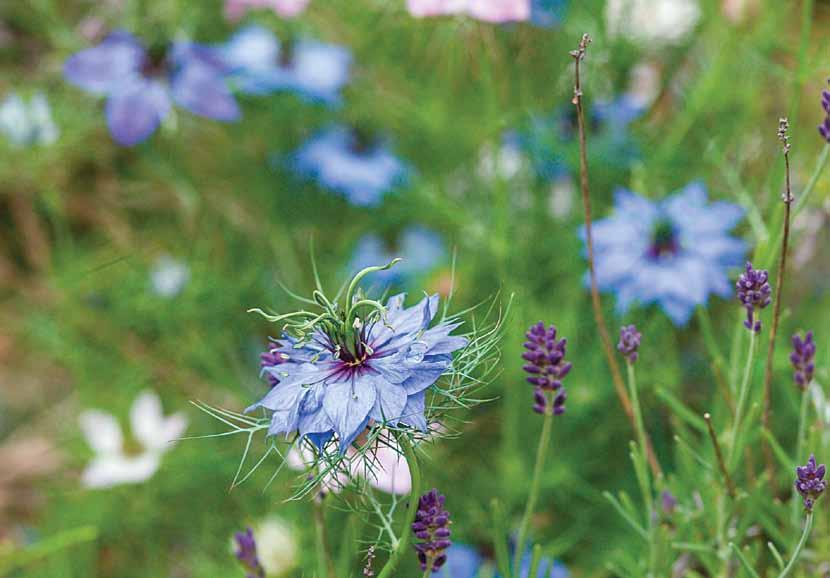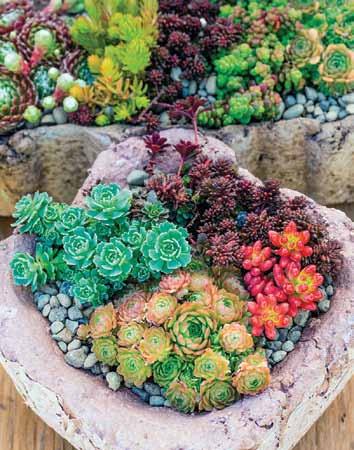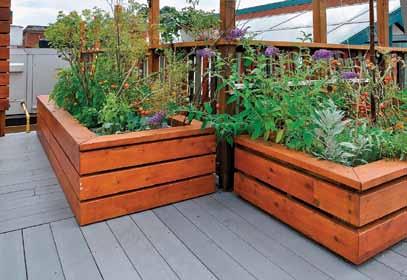
3 minute read
Encouraging wildlife in the smallest of spaces
Encouraging wildlife in the smallest spaces
WHILE OPTIONS FOR WILDLIFE GARDENING and naturalistic style plantings are greater for large plots, it is perfectly possible to create similar features in confined spaces, such as courtyards and patios, or even on balconies and roof terraces. Many features can be scaled down and plants and wildflowers added to pots, containers, raised beds or temporary growing bags.
Advertisement
SEASONAL POTS
In small gardens, choose plants with long seasons of interest for container displays. Include those that bloom for months rather than weeks, as well as plants with interesting and useful seed heads that last through autumn or winter, such as annual poppies and lovein-a-mist (Nigella), perennial and annual grasses, and teasels. When the potted wildflowers have finished in midsummer, replace them with autumn-flowering salvias, zinnias or single-flowered dahlias to provide a late blast of colour and valuable nectar for bees.
If your terrace or courtyard is shaded, choose early perennials, such as pulmonaria and doronicum, annuals such as honesty and bulbs such as snowdrops, crocus and winter aconite to offer early insect foragers much needed sustenance.
In hot, dry spaces, pot up hardy succulents, such as sedum or crassula, or mesembryanthemum, like doreanthus, which will be covered in brightly coloured blooms when the sun shines. Varieties of late sedums such as Hylotelphium spectabile or H.telphium, have colourful, sculptural foliage and heads of nectar-rich flowers that will be besieged with bees and butterflies in late summer. With a little more moisture, many alpine plants, such as Phlox subulata and the dwarf hardy geraniums, Geranium cinereum and G. subcaulescens, will provide mats of spring and summer flowers in patio containers.
The annual flower, love-in-the-mist (Nigella damascene), is ideal for sowing between small shrubs, such as lavender, or non-invasive ornamental grasses.
CLIMBING HIGH
Think about maximising use of your tiny space by clothing existing shrubs with smallerscale climbers; Clematis alpina or C. macropetala or the smaller hybrids are ideal, or opt for annual climbers, such as sweetpeas. Wall space is another important resource for planting. Woody, selfclinging climbers, such as ivy or climbing hydrangea, provide nesting and roosting sites for birds, while the heavenly scented flowers of honeysuckles (right) offer a feast for butterflies, and attractive red berries in late summer and autumn for birds. Also consider installing a green wall planting system packed with a range of drought-tolerant plants to add value to your vertical spaces.
GRASSY BEDS
Small borders or raised beds are ideal for clump-forming, noninvasive prairie grasses, such as the feathery Stipa tenuissima or taller Stipa gigantea with its oat-like flowers, upright purple moor grass (Molinia) or switch grass (Panicum). Summer flowers, such as Echinacea, Salvia, Veronica and geraniums, can be woven through the grasses to provide longer-term colour and seasonal interest. Annuals, including Ammi majus, yellow tidy-tips (Layia platyglossa) or love-in-a-mist (Nigella damascena) can also be sown into gaps or introduced as plugs.
Relatively flat roof space on a shed, garage or outbuilding could be converted into a green roof and covered with succulents or other drought-tolerant mat-forming species. Although the technology and products available for creating green roofs have significantly advanced in recent years, it’s always wise to consult a qualified, experienced installer or structural engineer for larger projects before starting, to ensure your building or structure can withstand the weight of the installation and it is appropriate for such a feature.
An extract from New Wild Garden by Ian Hodgson, published by Frances Lincoln

Even the smallest spaces can be planted for wildlife. Here a collection of moulded concrete planters contains a range of colourful, draught-tolerant succulent plants, such as houseleeks (Semperivivum) and sedums, which require very little care, save an occasional watering. A balcony vegetable garden sports tomatoes, brassicas and salad crops, together with pollinator-attracting buddleia and edible English marigolds, which both support many types of insects.


A casual and incidental atmosphere reign in this relaxed arrangement of perennials in rustic stone planters set around a tiny decked terrace.

A vibrant pink form of Phlox subulate cascades over the edge of a raised bed.










